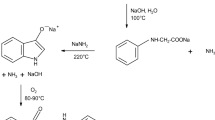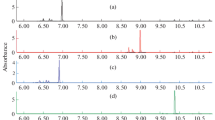Abstract
A novel and simple method utilizing a chromogenic reaction on filter paper is introduced for the rapid screening of banned aromatic amines released from azo dyes. The proposed method involves the sample preparation protocols outlined by the current standard method and the chromogenic reaction of extracted aromatic amines on filter paper. Based on the principle of the reaction between primary amines and aldehydes, p-dimethylaminobenzaldehyde (DMAB) was used as the chromogenic reagent for the rapid screening of 24 carcinogenic aromatic amines and aniline without any chromatographic instruments under optimized experimental conditions. The detection limit for all the aromatic amines in this study was less than 15 mg/kg. A total of 727 dyed textile samples were analyzed using both the present standard method and the proposed method simultaneously. Using the proposed method, a total of 471 samples did not require further instrumental analysis, which can dramatically save instrumental detection time (61.2%), can decrease instrumental detection costs, and can avoid the use of large amounts of toxic reagents. The proposed method has been applied to detect banned aromatic amines in some inspection institutions and dye factories and has large social and economic benefits.

Chromogenic reaction methods





Similar content being viewed by others
References
Robinson T, Mcmullan G, Marchant R, Nigam P. Remediation of dyes in textile effluent: a critical review on current treatment technologies with a proposed alternative. Bioresour Technol. 2001;77:247–55.
Ahlström L-H, Sparr Eskilsson C, Björklund E. Determination of banned azo dyes in consumer goods. TrAC Trends Anal Chem. 2005;24:49–56. https://doi.org/10.1016/j.trac.2004.09.004.
Kawakami T, Isama K, Nakashima H, Tsuchiya T, Matsuoka A. Analysis of primary aromatic amines originated from azo dyes in commercial textile products in Japan. J Environ Sci Health, Part A: Environ Sci Eng. 2010;45:1281–95. https://doi.org/10.1080/10934529.2010.493827.
European Parliament and the Council of the European Union. Regulation (EC) No 1907/2006 of the European Parliament and of the Council of 18 December 2006 concerning the Registration, Evaluation, Authorisation and Restriction of Chemicals (REACH), establishing a European Chemicals Agency, amending Directive 1999/45/EC and repealing Council Regulation (EEC) No 793/93 and Commission Regulation (EC)No 1488/94 as well as Council Directive 76/769/EEC and Commission Directives 91/155/EEC, 93/67/EEC, 93/105/EC and 2000/21/EC. Off J Eur Union. 2006;396.
European Union (1976) Council Directive of 27 July 1976 on the approximation of the laws, regulations and administrative provisions of the member states relating to restriction of the marketing and use of certain dangerous substances and preparations (76/769/EEC).
MdN S, Santos PM, Sappó CP, JLP P, Cordero BM. Microextraction by packed sorbent and salting-out-assisted liquid-liquid extraction for the determination of aromatic amines formed from azo dyes in textiles. Talanta. 2014;119:375–84. https://doi.org/10.1016/j.talanta.2013.11.041.
International Organization for Standardization. EN ISO 14362-1:2017 Textiles—methods for determination of certain aromatic amines derived from azo colorants—part 1: detection of the use of certain azo colorants accessible with and without extracting the fibres; 2017.
International Organization for Standardization. EN ISO 14362-3:2017 Textiles—methods for determination of certain aromatic amines derived from azo colorants—part 3: detection of the use of certain azo colorants, which may release 4-aminoazobenzene; 2017.
García-Lavandeira J, Salgado-Petinal C, Blanco E, Cela R. A sensitive and efficient procedure for the high throughput determination of banned aromatic amines in textiles and leather products aided by advanced sample composition. Anal Bioanal Chem. 2010;397:751–63. https://doi.org/10.1007/s00216-010-3574-2.
Sutthivaiyakit P, Achatz S, Lintelmann J, Aungpradit T, Chanwirat R, Chumanee S, et al. LC-MS/MS method for the confirmatory determination of aromatic amines and its application in textile analysis. Anal Bioanal Chem. 2005;381:268–76. https://doi.org/10.1007/s00216-004-2852-2.
Ming G. REACH textiles recall case studies. Dyeing Finish. 2011;37:40–2.
Yang S, Han J, Huan Y, Cui Y, Zhang X, Chen H, et al. Desorption electrospray ionization tandem mass spectrometry for detection of 24 carcinogenic aromatic amines in textiles. Anal Chem. 2009;81:6070–9. https://doi.org/10.1021/ac900411r.
Ye X, Niu Z, Li Y, Zhang Q, Gao Y, Luo X. A rapid qualitative screening method based on diazotization-coupling color reaction for determination of banned azo dyes in textile. Chin J Anal Chem. 2013;41:1107–10.
Wade LG Jr. Organic chemistry. 3rd ed. Upper Saddle River, NJ: Prentice Hall; 2003.
European Union. 2002/61/EC-2002 directive of the european parliament and of the council amending for the nineteenth time council directive 76/769/eec relating to restrictions on the marketing and use of certain dangerous substances and preparations azocolourants; 2002.
German Consumer Goods Ordnance. Second amendment to the German Consumer Goods Ordinance, Bundesgesetzblatt, Part 1. 1994:1670.
OEKO-TEX® (2017) STANDARD 100 by OEKO-TEX®, International Association for Research and Testing in the Field of Textile Ecologys. www.oeko-tex.com. Edition 02.2017.
Standardization Administration of China. GB 18401-2010 National General Safety Technical Code for Textile Products; 2010.
Acknowledgments
This work was supported by the science and technology planning project of the General Administration of Quality Supervision, Inspection and Quarantine (AQSIQ) of the P. R. China (2014IK159) and the National Quality Infrastructure (NQI) special project (2016YFF0203702). The authors thank Huirong Zhu, Jie Zhao, Ying Lai, and Tangtang Xie for their generous assistance. The authors acknowledge American Journal Experts for their assistance in English modification.
Author information
Authors and Affiliations
Corresponding author
Ethics declarations
Conflict of interest
The authors declare that they have no conflict of interest.
Rights and permissions
About this article
Cite this article
Ye, X., Peng, Y., Niu, Z. et al. Novel approach for the rapid screening of banned aromatic amines in dyed textiles using a chromogenic method. Anal Bioanal Chem 410, 2701–2710 (2018). https://doi.org/10.1007/s00216-018-0941-x
Received:
Revised:
Accepted:
Published:
Issue Date:
DOI: https://doi.org/10.1007/s00216-018-0941-x




